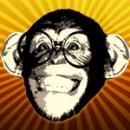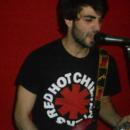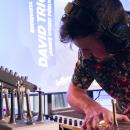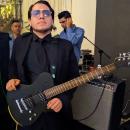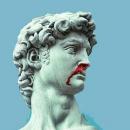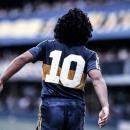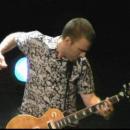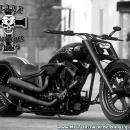Perdón por el reflote pero aquí cuenta qué efectos usa en cada canción de Stadium Arcadium:
http://www.guitarplayer.com/artists/1013/red-hot-chili-peppers&39-john-frusciante/16832
Frusci escribió:
“Dani California” I used a straight Strat tone on the first section of the first verse, and on the second section the guitar signal is split and panned in stereo, with the original part on the left, and a part processed using my Doepfer modular synth on the right. Basically, the signal from the tape is used to trigger an envelope generator (or ADSR), which responds to playing dynamics, and uses that information to dynamically control a low-pass filter. Unlike a typical envelope filter pedal, this setup allows me to create many more sounds than mere wah effects. Then, those two sections are repeated, and as I’m hanging on the sustained chord which transitions into the chorus, a Mellotron string part slowly rises behind the guitar. You can hardly hear the Mellotron, but it’s what makes it feel like something really big is about to happen. On the chorus, I doubled the guitar parts, which were played using a Boss DS-2 Turbo Distortion pedal.
The second verse begins with a couple of guitars playing in harmony. After they were recorded, I ran them through a Moog MF-105 MuRF (Multiple Resonance Filter Array) pedal six times, and recorded the results on individual tracks. The MuRF is very unpredictable, and sounded different on each pass. I kept going until I got a take that I really liked, though we actually wound up using all six takes in combination. Otherwise, the processing is the same as on the first verse.
For the bridge, the rhythm guitar is processed with the Doepfer’s LFO (Low-Frequency Oscillator) controlling its high-pass filter, so that the filter opens and closes rhythmically. The drums are also filtered, so that they are small and panned to one side at the beginning, then gradually get bigger and pan out across the full stereo spectrum, which lets you hear the guitar treatment more clearly.
On the third verse I overdubbed an additional rhythm guitar track. Then, on the buildup to the chorus, I added some diminished chords along with several harmony parts. To get the highest harmonies, we slowed the tape down and recorded them at a slower speed, so that they would be pitched above the range of the guitar when the tape was sped back up.
There are lots of additional harmony guitar parts on the second half of the third chorus, positioned in two groups panned to either side. Also, Eddie Kramer came in and showed our engineer how to do ’60s-style tape phasing, which we used on an early mix, and we wound up splicing a section of that mix into the part transitioning out of the chorus.
I played the original solo when we recorded the basic tracks, and then doubled it later, except for the super-fast wah part at the end, which was too difficult to double perfectly, so I put that section through a Delta Labs Effectron II digital delay set to a quick delay with just a touch of slow modulation.
Claro que eso es para estudio. Para tocarla uno bastaría con el wh10 para la segunda parte del verso, la ds2 para el estribillo y un big muff y otra vez el wh10 para el solo. También hay una especie de phaser antes del solo, el del estudio no se cuál será pero para directo lleva un phase 90.
 y he conseguido que el propio John Frusciante me grabara este video, para que pudieras ver como elaboró el tema...
y he conseguido que el propio John Frusciante me grabara este video, para que pudieras ver como elaboró el tema...

 y he conseguido que el propio John Frusciante me grabara este video, para que pudieras ver como elaboró el tema...
y he conseguido que el propio John Frusciante me grabara este video, para que pudieras ver como elaboró el tema...



